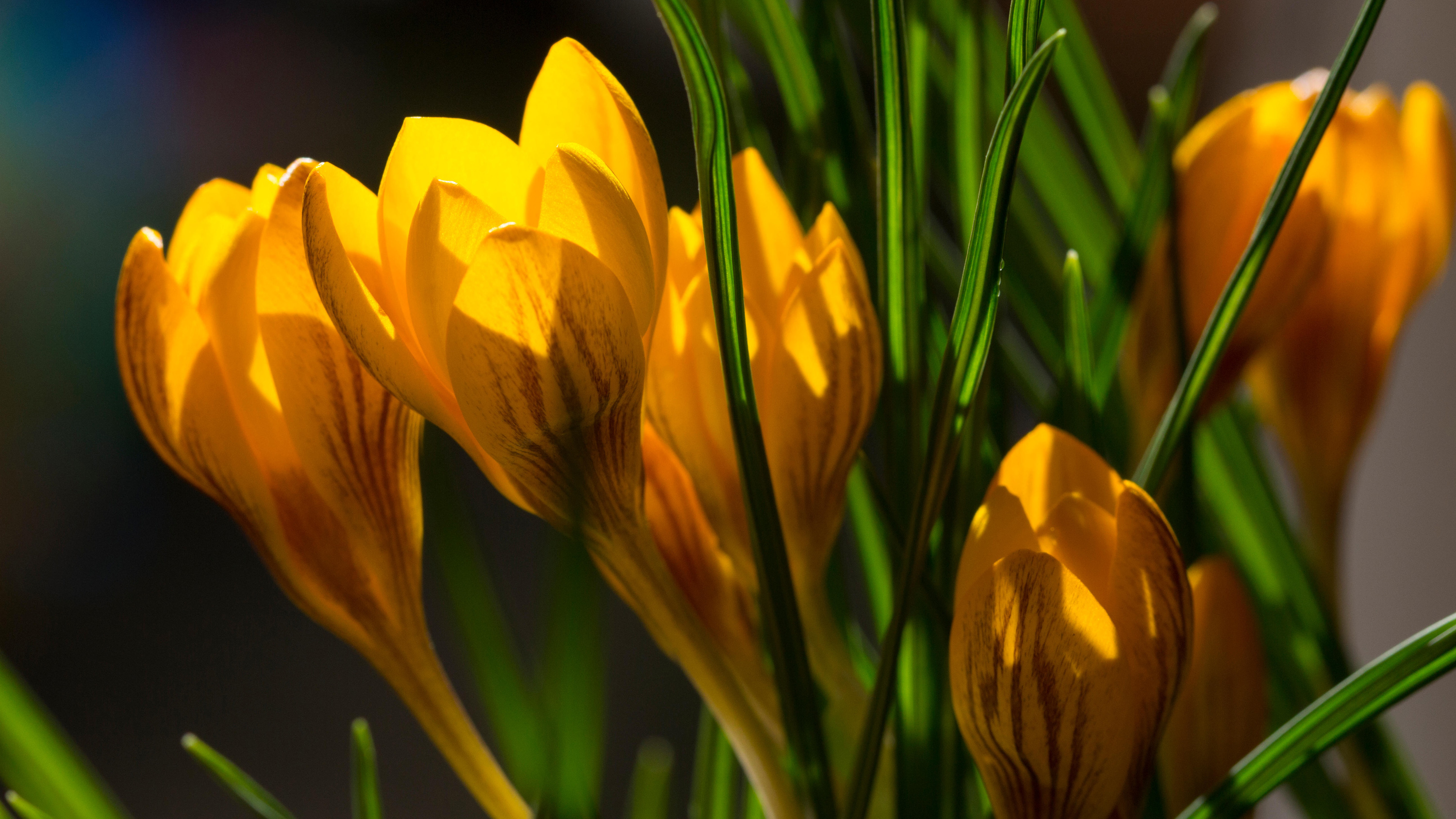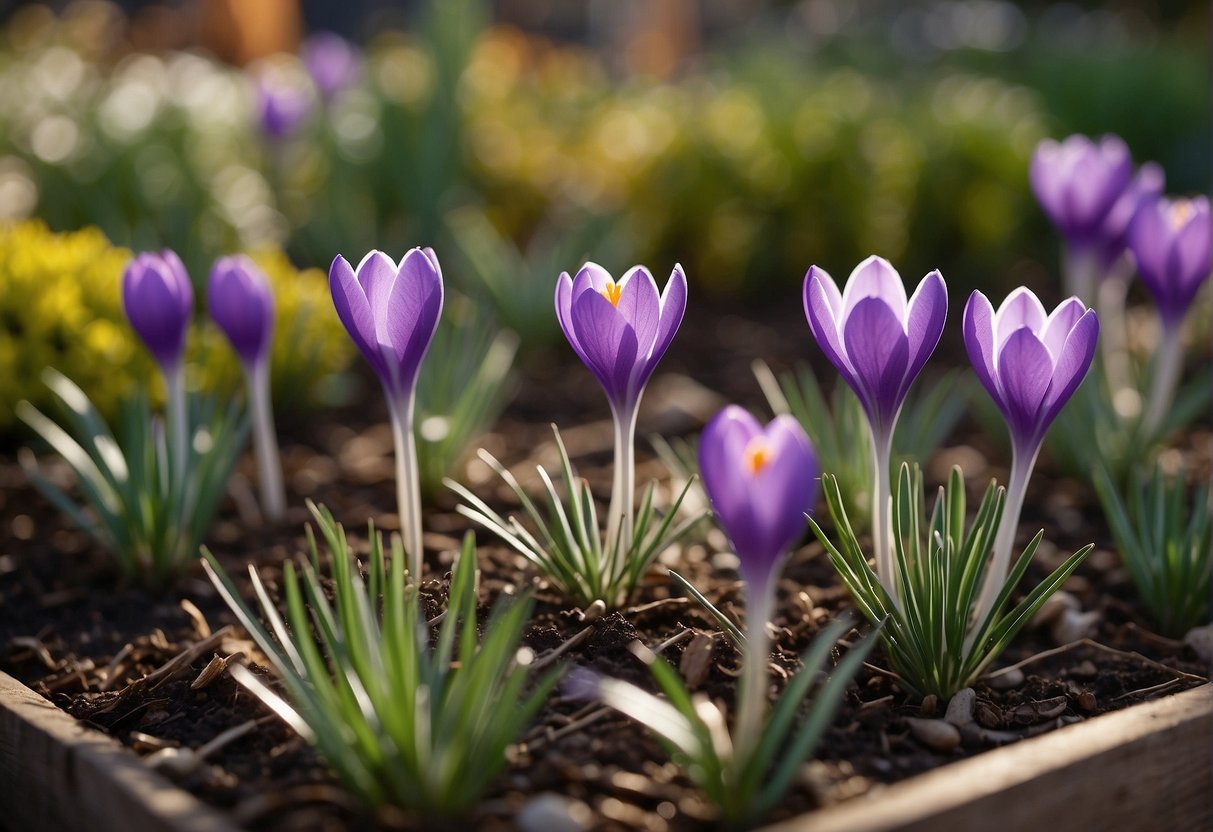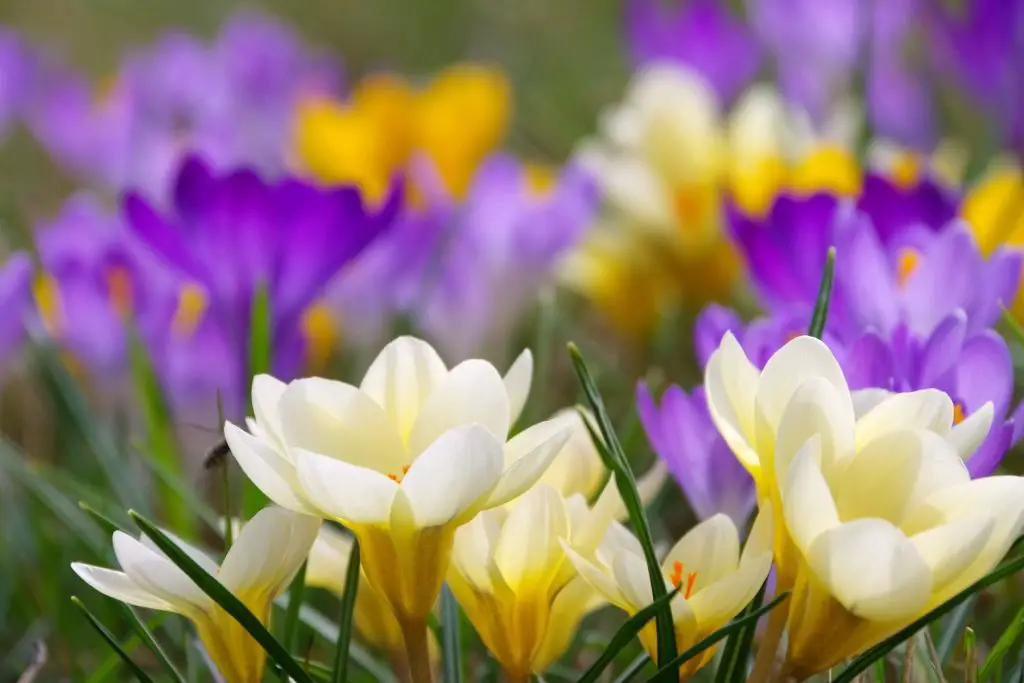Understanding the Life Cycle of Crocus Bulbs
Crocus bulbs, like many other spring-flowering bulbs, have a unique life cycle that requires careful planning to ensure proper growth and blooming. To determine when to plant crocus bulbs, it’s essential to understand the different stages of their life cycle. Crocus bulbs typically begin to grow roots in the fall, followed by a period of cold temperatures that induce flowering. This process, known as vernalization, is crucial for the bulbs to produce flowers in the spring.
During the winter months, crocus bulbs are dormant, and their growth is slowed down. However, as the weather warms up in the spring, the bulbs begin to produce foliage and flowers. The flowers typically bloom for 2-4 weeks, after which the foliage dies back, and the bulbs enter a period of dormancy again.
Planting crocus bulbs at the right time is critical to ensure they receive the necessary cold temperatures to induce flowering. In general, the ideal time to plant crocus bulbs is in the fall, about 6-8 weeks before the first frost. This allows the bulbs to establish themselves in the soil over the winter, and then bloom in the spring.
However, the exact planting time may vary depending on your location and climate. In warmer climates, it’s best to plant crocus bulbs in late winter to early spring, while in cooler climates, fall planting is still the best option. Understanding the life cycle of crocus bulbs and planting them at the right time will help ensure they bloom beautifully in the spring.
How to Determine the Ideal Planting Time for Your Region
Determining the ideal planting time for crocus bulbs in your region requires consideration of several factors, including climate, soil temperature, and frost dates. To ensure optimal growth and blooming, it’s essential to plant crocus bulbs at the right time for your specific area.
One way to determine the ideal planting time is to check the average frost dates for your region. In general, it’s best to plant crocus bulbs about 6-8 weeks before the first frost. This allows the bulbs to establish themselves in the soil over the winter, and then bloom in the spring. You can find the average frost dates for your area by checking online resources such as the Old Farmer’s Almanac or the National Weather Service.
Another factor to consider is soil temperature. Crocus bulbs prefer to grow in soil that is cool to moderate in temperature, typically between 40°F and 55°F (4°C and 13°C). You can check the soil temperature in your area by using a soil thermometer or by checking online resources such as the USDA’s Plant Hardiness Zone Map.
In addition to frost dates and soil temperature, climate is also an essential factor to consider when determining the ideal planting time for crocus bulbs. In warmer climates, it’s best to plant crocus bulbs in late winter to early spring, while in cooler climates, fall planting is still the best option.
Fortunately, there are many online resources and gardening apps available that can help you determine the ideal planting time for crocus bulbs in your region. Some popular options include Gardening Know How, Garden Plan Pro, and PlantSnap. These resources can provide you with personalized planting advice based on your specific climate, soil type, and frost dates.
By considering these factors and using online resources, you can determine the ideal planting time for crocus bulbs in your region and ensure optimal growth and blooming. Remember to plant crocus bulbs at the right time to ensure they receive the necessary cold temperatures to induce flowering, and enjoy beautiful blooms in the spring.
The Benefits of Planting Crocus Bulbs in the Fall
Planting crocus bulbs in the fall is one of the best ways to ensure a beautiful and vibrant bloom in the spring. By planting in the fall, crocus bulbs have the opportunity to establish themselves in the soil over the winter, which can lead to earlier blooming and a more robust display of flowers.
Another benefit of planting crocus bulbs in the fall is that it allows the bulbs to develop a strong root system before the winter. This can help the bulbs to survive the cold temperatures and moisture fluctuations that can occur during the winter months. As a result, fall-planted crocus bulbs are often more resilient and better able to withstand the challenges of the winter season.
In addition to the benefits for the bulbs themselves, planting in the fall can also make it easier to care for the bulbs. By planting in the fall, you can avoid the need for frequent watering and fertilization that can be required when planting in the spring. This can make it easier to maintain a healthy and thriving crop of crocus bulbs.
When planting crocus bulbs in the fall, it’s essential to choose a location with well-draining soil and full sun to partial shade. The bulbs should be planted at a depth of 3-4 times the height of the bulb, and spaced 3-6 inches apart. This will give the bulbs enough room to grow and bloom without becoming too crowded.
Some popular varieties of crocus bulbs that do well when planted in the fall include ‘Purpureus Grandiflorus’, ‘Remembrance’, and ‘Tricolor’. These varieties are known for their vibrant colors and robust blooms, and can add a pop of color to your garden in the spring.
Overall, planting crocus bulbs in the fall is a great way to ensure a beautiful and vibrant bloom in the spring. By choosing the right variety, planting at the right time, and providing the right care, you can enjoy a stunning display of flowers that will add color and beauty to your garden.
What to Consider When Planting Crocus Bulbs in the Spring
While fall is the ideal time to plant crocus bulbs, it’s not the only option. Planting in the spring can also be successful, but it requires careful consideration of several factors. One of the main considerations is the potential for warmer temperatures, which can cause the bulbs to bloom too early and reduce their flowering period.
Another consideration is the need for more frequent watering. Spring-planted crocus bulbs require consistent moisture to establish themselves, especially during the first few weeks after planting. This can be a challenge, especially in areas with low rainfall or high temperatures.
When planting crocus bulbs in the spring, it’s essential to choose varieties that are suitable for spring planting. Some popular varieties for spring planting include ‘Flower Record’, ‘Purpureus Grandiflorus’, and ‘Remembrance’. These varieties are known for their ability to bloom well in the spring and can add a pop of color to your garden.
In addition to choosing the right variety, it’s also important to plant the bulbs at the right time. In general, it’s best to plant crocus bulbs in the spring as soon as the soil can be worked. This is usually around late March or early April, depending on your location and climate.
When planting in the spring, it’s also important to plant the bulbs at the right depth. The bulbs should be planted 3-4 times deeper than the height of the bulb, and spaced 3-6 inches apart. This will give the bulbs enough room to grow and bloom without becoming too crowded.
Finally, it’s essential to provide the right care for spring-planted crocus bulbs. This includes watering consistently, fertilizing lightly, and protecting the bulbs from pests and diseases. By following these tips, you can enjoy a beautiful and vibrant bloom from your spring-planted crocus bulbs.
Preparing the Soil for Planting Crocus Bulbs
Before planting crocus bulbs, it’s essential to prepare the soil to ensure optimal growth and blooming. One of the most critical factors to consider is the drainage of the soil. Crocus bulbs prefer well-draining soil that is rich in organic matter. If the soil is too dense or heavy, it can cause the bulbs to rot or become waterlogged.
To prepare the soil for planting crocus bulbs, start by loosening the soil to a depth of about 8-10 inches. This will help to break up any clods and improve drainage. Next, add a layer of organic matter such as compost or manure to the soil. This will help to improve the soil’s structure and fertility.
It’s also essential to check the pH level of the soil before planting crocus bulbs. Most crocus varieties prefer a slightly acidic to neutral soil pH, ranging from 6.0 to 7.0. If the soil pH is too high or too low, it can affect the growth and blooming of the bulbs.
In addition to preparing the soil, it’s also important to consider the location where you will be planting the crocus bulbs. Choose a location that receives full sun to partial shade, and is protected from strong winds and extreme temperatures.
Once the soil is prepared, and the location is chosen, you can begin planting the crocus bulbs. Plant the bulbs at a depth of 3-4 times the height of the bulb, and space them 3-6 inches apart. This will give the bulbs enough room to grow and bloom without becoming too crowded.
By preparing the soil and choosing the right location, you can help to ensure that your crocus bulbs will grow and bloom successfully. Remember to plant the bulbs at the right time, and provide them with the right care and maintenance, and you will be rewarded with a beautiful and vibrant display of flowers in the spring.
Planting Crocus Bulbs: A Step-by-Step Guide
Planting crocus bulbs is a relatively straightforward process, but it does require some care and attention to detail. Here is a step-by-step guide to help you plant your crocus bulbs successfully:
Step 1: Choose a location with well-draining soil and full sun to partial shade. Crocus bulbs prefer a slightly acidic to neutral soil pH, ranging from 6.0 to 7.0.
Step 2: Prepare the soil by loosening it to a depth of about 8-10 inches. Add a layer of organic matter such as compost or manure to improve the soil’s structure and fertility.
Step 3: Plant the crocus bulbs at a depth of 3-4 times the height of the bulb. For example, if the bulb is 2 inches tall, plant it 6-8 inches deep. Space the bulbs 3-6 inches apart to allow for proper growth and blooming.
Step 4: Water the bulbs well after planting and keep the soil consistently moist during the first growing season. Avoid overwatering, which can cause the bulbs to rot.
Step 5: Apply a layer of mulch or compost to the soil surface to retain moisture and suppress weeds. This will also help to regulate the soil temperature and prevent extreme temperature fluctuations.
Step 6: Fertilize the bulbs lightly after planting, using a balanced fertilizer that is low in nitrogen. Avoid overfertilizing, which can cause the bulbs to produce weak and leggy growth.
Step 7: Monitor the bulbs for signs of pests or diseases, such as aphids, slugs, or fungal infections. Take action promptly if you notice any problems, using organic or chemical controls as needed.
By following these steps, you can help to ensure that your crocus bulbs are planted successfully and will bloom beautifully in the spring.
Caring for Crocus Bulbs After Planting
After planting crocus bulbs, it’s essential to provide them with the right care and maintenance to ensure they bloom beautifully in the spring. One of the most critical factors to consider is moisture. Crocus bulbs need consistent moisture during the first growing season, especially during the first few weeks after planting.
To provide adequate moisture, water the bulbs well after planting and keep the soil consistently moist during the first growing season. Avoid overwatering, which can cause the bulbs to rot. It’s also essential to fertilize the bulbs lightly after planting, using a balanced fertilizer that is low in nitrogen.
In addition to moisture and fertilization, it’s also important to protect the bulbs from pests and diseases. Keep an eye out for signs of pests or diseases, such as aphids, slugs, or fungal infections. Take action promptly if you notice any problems, using organic or chemical controls as needed.
Another important aspect of caring for crocus bulbs is deadheading. After the flowers have bloomed, remove the flower heads to encourage the bulbs to focus their energy on re-growing and storing energy for next year’s bloom. This will also help to prevent the bulbs from producing seeds, which can weaken the plant.
Finally, it’s essential to allow the foliage to die back naturally after blooming. This will help the bulbs to store energy for next year’s bloom. Avoid cutting back the foliage too early, as this can weaken the plant and reduce next year’s bloom.
By providing the right care and maintenance, you can help to ensure that your crocus bulbs bloom beautifully in the spring and come back year after year. Remember to plant the bulbs at the right time, and provide them with the right conditions, and you will be rewarded with a stunning display of flowers.
Common Mistakes to Avoid When Planting Crocus Bulbs
When planting crocus bulbs, there are several common mistakes to avoid in order to ensure successful growth and blooming. One of the most common mistakes is planting the bulbs too early or too late. Planting too early can cause the bulbs to bloom too soon, while planting too late can cause the bulbs to miss the optimal blooming period.
Another common mistake is not providing adequate care and maintenance. Crocus bulbs need consistent moisture, fertilization, and protection from pests and diseases in order to thrive. Failure to provide these basic needs can result in weak and spindly growth, or even complete failure to bloom.
Additionally, many gardeners make the mistake of planting crocus bulbs in areas with poor drainage or heavy shade. Crocus bulbs prefer well-draining soil and full sun to partial shade, so it’s essential to choose a location that meets these requirements.
Some gardeners also make the mistake of planting crocus bulbs too deeply or too shallowly. Planting the bulbs too deeply can cause them to rot, while planting them too shallowly can cause them to dry out. It’s essential to plant the bulbs at the correct depth, which is typically 3-4 times the height of the bulb.
Finally, many gardeners fail to deadhead their crocus bulbs after blooming. Deadheading is essential to encourage the bulbs to focus their energy on re-growing and storing energy for next year’s bloom. Failure to deadhead can result in weak and spindly growth, or even complete failure to bloom.
By avoiding these common mistakes, you can help to ensure that your crocus bulbs thrive and bloom beautifully in the spring. Remember to plant the bulbs at the right time, provide adequate care and maintenance, and choose a location that meets their needs.









